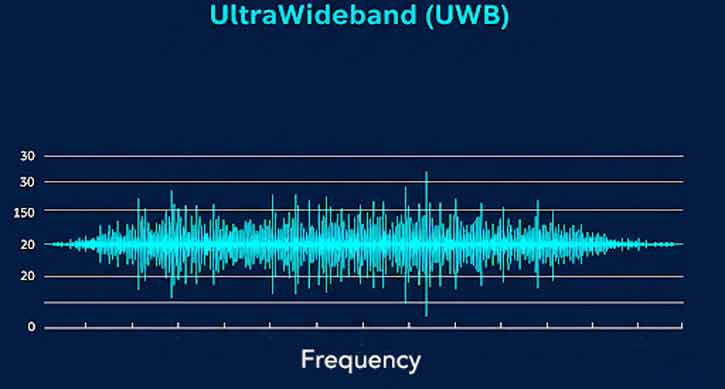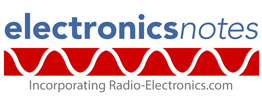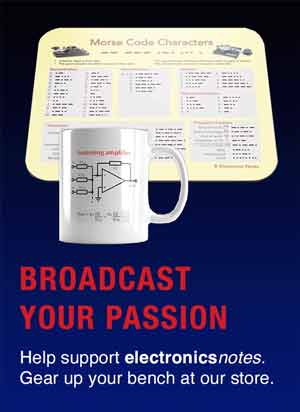Understanding Ultra-wideband-UWB: a basic 101 introduction
Ultra-wideband, UWB has been in existence for many years, but it is now coming to the fore to be used in many types of application including automotive technology and other areas where proximity sensing is needed.
Home » Radio & RF technology » this page
UWB ultrawideband Includes:
UWB basics
In an increasingly interconnected world, the ability to precisely locate and communicate with devices in real-time is becoming paramount.
While technologies like Bluetooth and Wi-Fi continue to perform well, a new contender called Ultrawideband, UWB has emerged, promising unprecedented accuracy and security in short-range wireless interactions.

UWB isn't just another incremental improvement in wireless communication; it's a fundamentally different approach to transmitting and receiving radio waves.
Instead of relying on narrow frequency bands and continuous sine waves, UWB utilizes a signal spread across a very wide spectrum of radio frequencies.
This unique characteristic gives it a distinct set of advantages, making it a game-changer in various applications, from precise positioning and secure access to high-bandwidth data transfer.
UWB development
The development of UWB technology stems from work that was undertaken by the US military into defining the behaviour of microwave networks to impulse or transients. The work which was started in 1962.
Traditionally networks had been characterised according to their response in the frequency domain where parameters such as amplitude and phase with respect to frequency are important. However the new approach which was to spawn the first ideas about ultra wide band or UWB technology looked at the impulse response.
At the time measurements were difficult to make as test equipment with a sufficiently high bandwidth was not available.
The fact that the research was investigating an area where the supporting technologies such as test equipment were not sufficiently developed placed restraints on the research, but nevertheless investigations into the technology continued.
Having looked at the response of microwave networks to impulses, the next major step forward occurred when the techniques were applied to radiating systems. Once this work commenced in 1968 it soon became obvious that UWB technology could be used for radar and communications applications.
The rate at which work was undertaken was increased in the 1970s and 80s as the supporting technologies became available. During this period it was termed carrier free or impulse technology.
The term ultra wide band or UWB was only coined in the later 1980s by the US Department of Defense. However by this time many patentees had been awarded and a considerable degree of development had been invested in the technology.

Development of UWB technology was primarily intended for military applications and it was classified. As a result little development took place in the commercial arena.
However in the years following 2000, commercial wireless communications became established. Technologies such as 802.11 (Wi-Fi), Bluetooth and others became established.
These paved the way, and showed the flexibility offered by wireless communications for a very wide variety of applications from mobile phone peripheral connectivity to mobility and connectivity for laptops. These technologies and others grew rapidly.
Accordingly commercial applications for ultra wideband UWB became very apparent and commercial exploitation started
One of the major limitations to the speed at which UWB could enter the commercial marketplace was legislation. In view of the fact that UWB occupies a wide bandwidth, even though at a low power level, it has to exist alongside traditional transmissions without causing any undue interference.
Accordingly the legislative bodies and in particular the FCC in the USA have been proceeding with caution.
Any changes in direction required will be far more difficult to address in later years once UWB technology is firmly established. Despite this UWB transmissions are allowed, provided that they remain within a given power density and frequency profile. This ensures that the allowed transmission levels do not cause any noticeable interference to existing transmissions.
What is UWB? - the FCC definition
To date the FCC in the USA has approved UWB for indoor and short range outdoor communication, but with restrictions on the frequencies over which the transmission can spread as well as the power limits. This will enable the UWB transmissions to communicate successfully, but without affecting existing 'narrowband' transmissions
To achieve these requirements the FCC has mandated that UWB transmissions can legally operate in the range 3.1 GHz up to 10.6 GHz, at a limited transmit power of -41dBm/MHz. Additionally the transmissions must occupy a bandwidth of at least 500 MHz, as well as having a bandwidth of at least 20% of the centre frequency. To achieve this last requirement, a transmission with a centre frequency of 6 GHz, for example, must have a bandwidth of at least 1.2 GHz. Consequently, UWB provides dramatic channel capacity at short range that limits interference.
The fact that very low power density levels are transmitted means that the interference to other services will be reduced to limits that are not noticeable to traditional transmissions. Additionally the lowest frequencies for UWB have been set above 3 GHz to ensure they do not cut across bands currently used for GPS, cellular and many other services.
Basic concepts
As the name implies UWB, ultra wide band technology, is a form of transmission that occupies a very wide bandwidth. Typically this will be many Gigahertz, and it is this aspect that enables it to carry data rates of Gigabits per second.
Unlike traditional radio systems that transmit information by modulating the amplitude, frequency, or phase of a continuous carrier wave within a narrow band,
Despite the single named used for the ultra wideband (UWB) transmissions, there are two very different technologies being developed.
The fact that UWB transmissions have such a wide bandwidth means that they will cross the boundaries of many of the currently licensed carrier based transmissions. As such one of the fears is that UWB transmission may cause interference.
However the very high bandwidth used also allows the power spectral density to be very low, and the power limits on UWB are being strictly limited by the regulatory bodies.
In many instances they are lower than the spurious emissions from electronic apparatus that has been certified. In view of this it is anticipated that they will cause no noticeable interference to other carrier based licensed users. Nevertheless regulatory bodies are moving forward cautiously so that users who already have spectrum allocations are not affected.
At its core, UWB is a radio technology defined by its exceptionally wide bandwidth, typically exceeding 500 MHz or occupying more than 20% of its center frequency, as regulated by bodies like the FCC and ITU-R. This vast spectral occupancy is the key differentiator between UWB and narrowband or broadband wireless technologies.
- Carrier free direct sequence ultra wideband technology: Using this form of UWB, communication or sensing is done by sending a series of very short, low-power pulses. These pulses, often just a few nanoseconds in duration, contain a wide range of frequencies spread across the ultrawide bandwidth.
- MBOFDM, Multi-Band OFDM ultra wideband technology: This form of ultra wideband technology uses a wide band or multiband orthogonal frequency division multiplex (MBOFDM) signal that is effectively a 500 MHz wide OFDM signal. This is 500 MHz signal is then hopped in frequency to enable it to occupy a sufficiently high bandwidth.
Advantages of UWB
The unique spread spectrum nature nature of UWB gives it several distinct operational advantages:
Precise Time-of-Flight (ToF) Measurement: The for the pulsed form of UWB, the extremely short duration of UWB pulses allows for highly accurate measurement of the time it takes for a signal to travel between two devices. By multiplying the ToF by the speed of light, the distance between the devices can be determined with centimeter-level accuracy. This is a significant advantage over technologies that rely on signal strength (RSSI), which can be affected by environmental factors and provide much less precise distance estimations.
High Bandwidth for Data Transfer: The vast spectral occupancy of UWB enables the transmission of large amounts of data over short distances. While the power levels are low to avoid interference with other radio services, the sheer bandwidth allows for data rates significantly higher than Bluetooth Low Energy (BLE) and competitive with some Wi-Fi standards for short-range communication.
Robustness Against Multipath Interference: In indoor environments, radio signals often bounce off walls, furniture, and other objects, creating multiple signal paths (multipath). Narrowband signals can experience fading and distortion due to these reflections interfering with the direct signal. However, the short pulses of UWB have a high time resolution, allowing the receiver to differentiate between the direct path signal and the delayed reflections, mitigating the effects of multipath interference and ensuring more reliable communication and accurate ranging.
Low Power Consumption: Despite its wide bandwidth, UWB typically operates at very low power levels. This is partly due to the short duty cycle of the pulses. This low power consumption makes it ideal for battery-powered devices and applications where energy efficiency is critical.
Coexistence with Other Radio Technologies: UWB signals are spread across a wide frequency range at very low power spectral density. This "noise-like" characteristic makes it less likely to interfere with narrowband and carrier wave transmissions operating in the same frequency bands.
Applications of UWB Technology
The unique capabilities of UWB – precise positioning, high bandwidth, robustness, and low power consumption – have opened the door to a wide array of innovative applications across various industries
Precise Location and Tracking: This is arguably the most transformative application of UWB. Its centimeter-level accuracy makes it ideal for:
Indoor Positioning Systems (IPS): Navigating within buildings like shopping malls, hospitals, and warehouses with much greater accuracy than Wi-Fi or Bluetooth-based systems.
Asset Tracking: Real-time tracking of valuable assets in logistics, manufacturing, and healthcare, improving efficiency and reducing losses.
People Tracking: Locating personnel in industrial environments for safety and workflow optimization.
Social Distancing Solutions: Enabling accurate proximity detection for workplace safety and contact tracing.
Secure Access Control: UWB's precise distance measurement and inherent resistance to relay attacks make it a highly secure technology for:
Hands-Free Car Keys: Automatically unlocking and starting vehicles as the user approaches with their UWB-enabled smartphone or key fob, offering enhanced security against theft.
Building and Room Access: Providing seamless and secure entry and exit to buildings and restricted areas without the need for physical keys or keycards.
High-Bandwidth Short-Range Communication: While not its primary focus, UWB's high bandwidth capabilities enable fast and reliable data transfer for applications like:
Device-to-Device File Sharing: Quickly transferring large files between nearby UWB-enabled devices.
Wireless Augmented and Virtual Reality (AR/VR): Providing low-latency, high-bandwidth connections for immersive AR/VR experiences.
Contactless Payments: Enabling secure and convenient hands-free payments at point-of-sale terminals.
Gesture Recognition and Interaction: UWB's ability to sense subtle movements and distances can be used for:
*Point-and-Control Interfaces: Interacting with smart devices by pointing gestures with a UWB-enabled remote or smartphone.
Smart Home Automation: Triggering actions based on user proximity and gestures within a room.
Automotive Applications: Beyond keyless entry, UWB is finding applications in:
Advanced Driver-Assistance Systems (ADAS): Enhancing the accuracy of proximity sensors and enabling new safety features.
Vehicle-to-Everything (V2X) Communication: Facilitating precise localization and communication between vehicles and infrastructure.
Healthcare: UWB's low power and ability to penetrate human tissue (at very low power levels) are being explored for:
Vital Sign Monitoring: Developing wearable sensors for precise and continuous monitoring of heart rate, respiration, and other vital signs.
Medical Imaging: Investigating its potential as a safer alternative to certain types of medical imaging.
Industrial Automation and Robotics: UWB's real-time accuracy and low latency are crucial for:
Precise Robot Navigation and Control: Enabling robots to navigate complex industrial environments with high precision.
Human-Robot Collaboration: Ensuring safe and efficient interaction between humans and robots in shared workspaces.
UWB technology is poised to play a significant role in shaping the future of wireless interactions. Its unique combination of precise positioning and secure communication is unlocking a new dimension of spatial intelligence for connected devices.
As the technology matures and becomes more widely integrated into smartphones, wearables, and other devices, we can expect to see a proliferation of innovative applications that seamlessly blend the digital and physical worlds.
From truly hands-free experiences and hyper-accurate location-based services to more secure transactions and intuitive human-device interactions, UWB is paving the way for a future where our devices are not just connected, but also contextually aware of their spatial surroundings with unprecedented accuracy.
The journey of unlocking the full potential of this revolutionary technology has just begun, and the possibilities are truly boundless.
 Written by Ian Poole .
Written by Ian Poole .
Experienced electronics engineer and author.
More Essential Radio Topics:
Radio Signals
Modulation types & techniques
Amplitude modulation
Frequency modulation
OFDM
RF mixing
Phase locked loops
Frequency synthesizers
Passive intermodulation
RF attenuators
RF filters
RF circulator
Radio receiver types
Superhet radio
Receiver selectivity
Receiver sensitivity
Receiver strong signal handling
Receiver dynamic range
Return to Radio topics menu . . .




